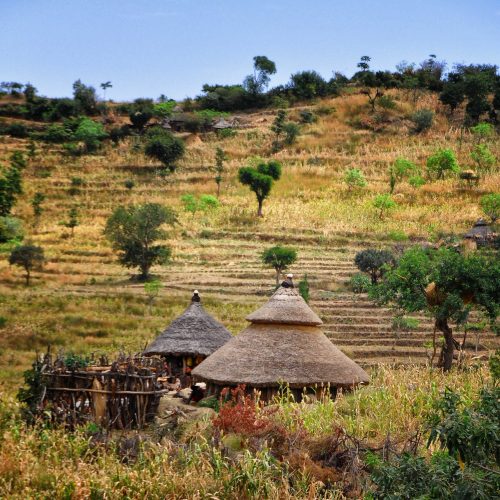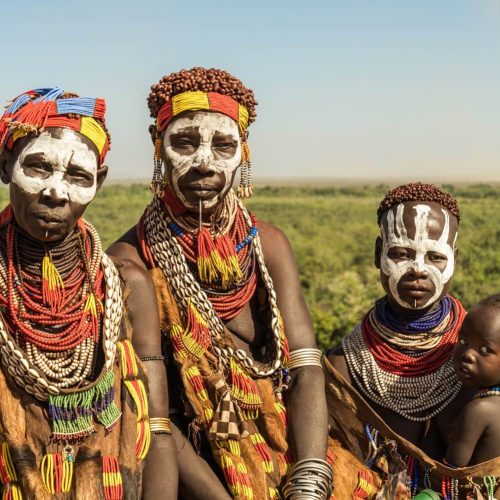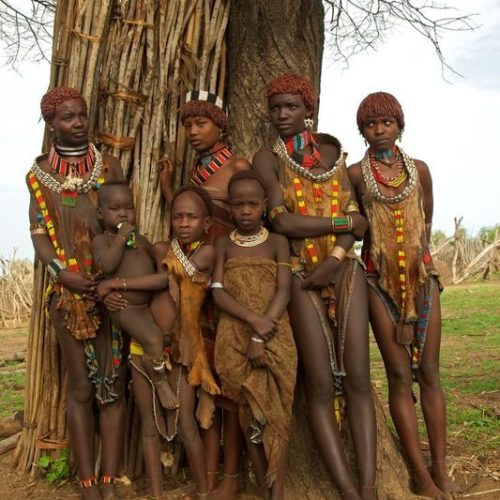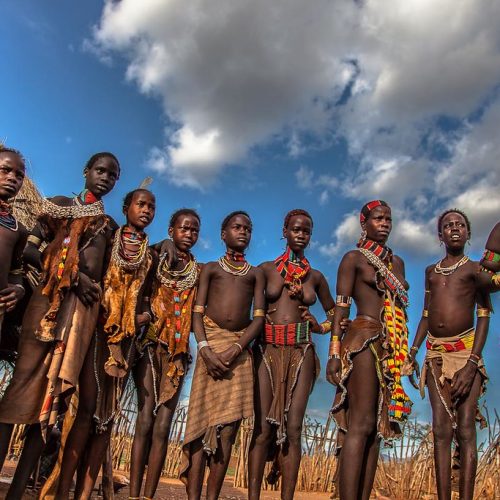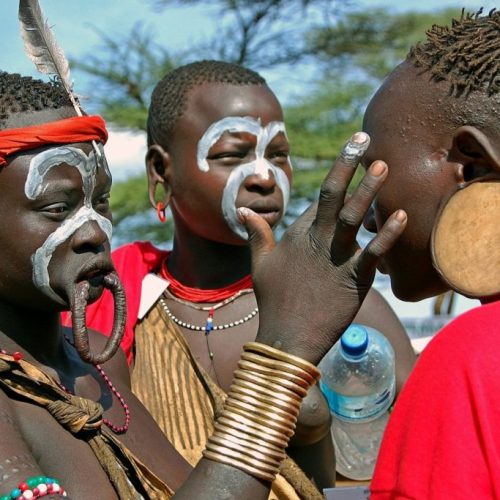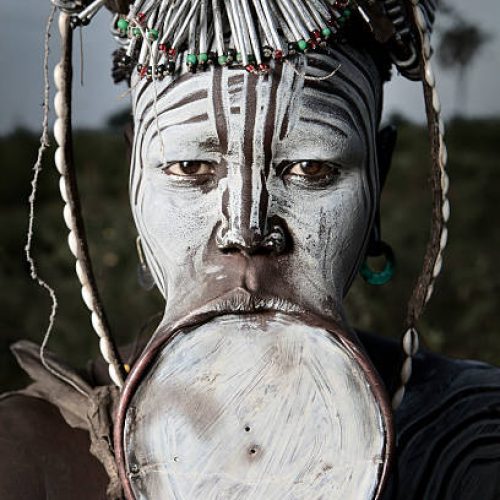7 Days of Tribal Experiences in Ethiopia's Omo River Valley
Discover the wonders of Ethiopia – if you have been looking a nice combination of tour
package that compose from a remarkable collection of landscapes to the Omo Valley
with its peoples and cultures and the historical Islamic Center of Harar with visiting
Awash National Park on the way, don’t search out further – just you are here in the
perfect tour itinerary. You’ll visit the colorful culture of the tribes in the Omo Valley with
its unforgettable local markets. And you will proceed further to the Harar and Awash
National Park through some of the Rift Valley Lakes.
Day 1
ARRIVAL TO ADDIS ABABA AND CITY TOUR
On arrival in Addis Ababa you will be met at the airport and transferred to the hotel. Addis was
founded in 1886 by Menelik II, and situated at an elevation of around 2438m which makes it the
third highest capital city in the world. Addis Ababa enjoys an excellent climate all year round,
with an average temperature of 25°C. we will start our site-seeing by the National museum
which houses some of the country’s historic treasures. The collection of fossils and bones of
early hominids discovered in Ethiopia include the 3.5 million year old remains of ‘Lucy’, the
oldest hominid every found. Proceed visiting the two major highlights of the city, the
Ethnographic Museum and the church of the Holy Trinity, Ethiopia’s main cathedral and home to
the remains of the last emperor, Haile Selassie.
Day 2
ADDIS ABABA TO ARBA MINCH
After breakfast, drive to the famous lakeside town of Arba Minch. En route visit the villages of
Gurage for their staple food of Kocho made from the false banana. We drive through one of the
most colorful and scenic areas of Southern Ethiopia, a land that is inhabited by the Wolayita
people, who were once nomads but are now farmers. Before arriving to the town of Arba Minch,
a long section of the road offers magnificent views of lake Abaya, surrounded by mountains.
The lake has volcanic origins and is almost pink in color
Day 3
Visit THE CHENCHA VILLAGE AND BOAT TRIP ON LAKE CHAMO
Morning drive 40kms northwest of Arba Minch to Guge Mountains to visit the Dorze and
Chencha villages. Once warriors, the Dorze have now turned to farming and weaving to earn a
living. They speak an Omotic tongue and the Dorze name is synonymous with the best woven
cotton cloth. The “elephant huts” of the Dorze are unique and worth seeing. Also, the Dorze
beehive-shaped houses are constructed entirely of organic material and has its own small
garden surrounded by beds of spices, cabbage and tobacco. Some of Ethiopia’s best woven
cottons come from Chencha, which is located 8 km northwest of Dorze Village. Men weave and
women spin. Afternoon a boat trip on clear blue waters of Lake Chamo to see the crocodiles,
hippos & aquatic bird species. The northern shores of Lake Chamo are famous for its large
crocodiles, which can be seen in great numbers lounging in the heat. The lake is about 32km
long and provides a lush wetland habitat for many species of flora and fauna/.
Day 4
DRIVE TO JINKA VIA KONSO AND KAY AFER
Early morning drive to Konso where colorfully costumed dress, impressive terracing of the land
and unusually engraved wooden statues used as grave markers can be seen. Differing from
their neighbours, the Konso are pure agriculturists, famed for their use of the stone terraces that
they utilize to such good effect in this dry and barren region of basalt hills. Originally from the
east and speaking an east Cushitic language, the Konso live in settlements that are surrounded
by stone walls. A generation pole classifies the age of each town and each family lives in
compounds that are accessible only through gateways that require the visitor to enter on all
fours thereby rendering any potential attackers vulnerable. Keep driving to Key Afer for the
colourful Thursday market where we should see and photographed the Ari, Bena, Hamer and
Tsemay people. The Bena and Hamer women usually favour red clay braids in their hair, shiny
with butter and perfumed with incense. The long beaded skirts of the Tsemay have a stick
incorporated in the back to denote a married woman and the men have elaborately plaited
hairstyles decorated with feathers and colourful beads. After visiting the market we drive on to
Jinka, often called the gateway to the Omo Valley.
Day 5
VISIT THE MURSI TRIBES IN MAGO NATIONAL PARK
Early morning drive to Mago National Park, from here, visit the Mursi highlands where the most
illustrious of Ethiopia’s unique tribes lives. The Mursi are known all over the world, for their
decorative lip plates that adorn the lower lips of the Mursi women. The plates stretch the lower
lip beyond imagination and the women’s beauty , pride and desirability is determined in direct
proportion to the size of the plate. The Mursi men and women may appear gracious but the
Mursi warriors are not to be sneezed at. On their arms are deep crescent incisions that
represent each enemy they have killed in battle. The men are also famous for their hairstyle.
The various cultural aspects of the tribe will be explained and you will be able to take their
photographs but not for free. Back to Jinka for your lunch and afternoon go to the Ari Village
near by the town of Jinka for experiencing and learning the culture of Ari tribe and explore how
they make their traditional homemade alcoholic drinks.
Day 6
DRIVE TO TURMI AND VISIT THE HAMER TRIBES
This day, we will continue driving through the Omo Valley region to Turmi via Dimeka. The
Hamer tribe is one of the largest groups in the Valley. The Hamer cultivate millet, vegetables,
tobacco and cotton as well as raising cattle and goats. They are known for the fine pottery they
produce as well as their remarkable hairstyling. Most dramatic of all are the clay hair buns with
ostrich feathers that the men don when they have killed a fierce animal. The Hamer women are
simply stunning. The women wear beaded necklaces and iron coils around their arms and
decorate their skin with cowry shells. These decorations indicate the wealth and prestige of a
woman’s husband.
Day 7
TURMI – MURULLE – TURMI
This day morning, we continue through the savannah along tracks that are barely visible,
passing through a vast meadowland with shrubs and umbellifers (‘umbrella’ acacia trees) for an
excursion to the Murulle area. We arrive at Korcho village with beautiful views over the Omo
River to see the Karo ethnic group, experts in body painting, using clay and locally available
vegetable pigments to paint fantastic patterns on each other’s faces, chests, arms and legs.
These designs have no special symbolic significance, but are created purely for fun and
aesthetic effect, each artist vying to out-do their fellow artists. Karo men also sculpt and shave
their hair into extravagant shapes, with special ochre “caps” of hair usually containing several
ostrich feathers. En route have a picnic lunch. We then drive back to the village of Turmi.
Day 8
EXCURSION TO OMORATE
This morning we start driving south to Omorate to visit another tribe, the Dasenech (formerly
known as Geleb), and one of their villages. These people inhabit the areas bordering with
Kenya, north of Lake Turkana, and they live on the east and west bank of the Omo River. They
are agro-pastoralist and herd cattle and practice flood retreat cultivation on both sides of the
river.The Geleb Covering a large territory, the Geleb live along the western banks of the Omo
River, having been forced out of the Turkana region by conflict in the 18th century. Originally
nomadic pastoralists, the more fertile surroundings of the Omo River has caused them to put
down more permanent roots based around fishing and agriculture. The Geleb live in small huts
that befit their nomadic origins, as they could be easily and quickly dismantled. Women wear a
pleated cowskin skirt with necklaces and bracelets. Men wear a checkered cloth around their
waist only. Then drive back to our base Turmi.
Day 9
DRIVE FROM TURMI TO YABELLO
This day we will drive to Yabello visiting the Erbore people en route. After lunch stop at Konso,
continue to the region of Oromo Borena and visit their village. The drive this day will let you to
experience the life of the Oromo Borena People who is well known in cattle rearing. We also
visit the Oromo Borena People villages and their ‘singing well’ from which they cater water to
their own thousands of cattle by singing.
Day 10
EXCURSION TO EL SOD CRATER LAKE
This morning we will proceed to the crater lake of El Sod,known locally as the House of Salt. El
Sod’s deep crater is famous for the black salt that has been extracted from its inky depths for
centuries. We will view the lake from the rim and take a short walk along the top. Probably,
ubiquitous donkeys can still be seen winding their way up the side of the crater loaded with the
valuable mineral. Then, we will drive back to Yabello, famed for its unique position as home for
two of Ethiopia’s Endemic birds; the white-tailed swallow and Stresemann’s bush crow.These
birds can only be found in the acacia scrubland around Yabello.
Day 11
DRIVE TO YIRGALEM
Today we drive to Yiregalem over a beautiful Sidamo mountains and coffee plantation. On the
way, we stop at Wenago to visit the Tutu Fella stelae field – an unusual collection of carved
stones.Little is known about the origin of these stelae or the reason for their erection, though it is
thought that they date from the 9th century. This is a driving day to make it to our traditional
Sidamo style lodge. We can take a short walk in the late afternoon through the lovely natural
eco-system and admire the Sidama Coffee farm.
Day 12
-DRIVE TO LAKE LANGANO
This day, we drive to the Lake Awassa, one of the Rift Valley Lakes. Lake Awasa is rich in
variety of plankton and fish inhabit in the lake and support an interesting lakeside Fish market
by the locals. keep driving to Lake Langano and enjoy more of the Rift Valley landscape and the
stunning views over the Lakes of Abijata and Shala. We have the possibility of visiting the
Ostrich farm at Abijata Shala National Park. In the afternoon we will check in to the lake
langano, side resort for our overnight.
Day 13
DRIVE TO AWASH NATIONAL PARK
Today we will drive to the Awash National Park and afternoon arrive in the park ,the scenic
Awash National Park located in the dry acacia savanna of the Rift Valley. The skyline of the park
is dominated by the jagged edges of Mount Fantelle, a dormant volcano whose crater towers
above the surrounding bush. This aftenoon we will have an opportunity to visit its splendid
waterfall spilling into a 150m gorge. We may also have the opportunity to spot some of the parks
wildlife. The most visible large mammals are the Beisa Oryx, Soemmering’s gazelle and the
Slat’s dik-dik.
Day 14
DRIVE TO HARAR
Today we drive to Harar on the way we will visit the town of Aweday famous as the site of the
country’s largest chat market and farming place (an stimulating plant). Harar is a walled city. The
city walls are pierced by 5 gates topped by 25 towers. The 16th century mosque with its slender
minaret and the narrow streets lined with small shops all give the impression of having
wandered into a city from the Arabian nights. In the evening, we will go to one of the gates of
the Harar wall to see the Hyena Man feeding his hyena friends.
Day 15
EXPLORING HARAR ON FOOT AND DRIVE BACK TO DERI DAWA
Harar is the cradle of Islam in Ethiopia and by the Middle Ages, Harar had become known as
the fourth most sacred city in the Islamic world. The City Wall, the Gates and the narrow streets
lined with traditional Harari Gegar houses, the colorful Muslim and Christian markets (known for
basketry). After lunch, visit the Hareri museum, Rimbaud House, a fine traditional house dating
from the period when the French poet Rimbaud lived in Harer. Finally visit the traditional Hararie
house within the famous walled city. In the afternoon, we will transfer to the Dire Dawa for our
overnight stays
Day 16
DRIVE BACK TO ADDIS ABABA AND DEPARTURE
This day, we drive back to Addis Ababa on the way we will see some of the creator lake of
Debre Zeit. We will arrive in Addis Ababa in early afternoon and transfer to the Hotel and have a
room as a day use for wash/change and get ready for the evening flight. You might be interested
in last minute souvenir shopping at the markets. In the evening, we will go out to one of the best
cultural restaurants for the Farewell Dinner at a traditional restaurant with a live traditional
dances program. Then, we will transfer to the airport for the flight home. The trip ends here
